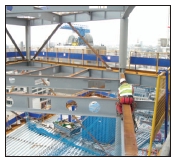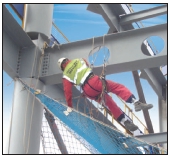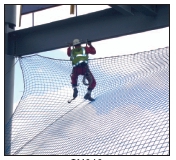| With
the shocking rise in the annual number of deaths in the construction
industry last year the importance of safety netting is more relevant than
ever before |
| The
size of the job, big or small makes no difference; if you have employees
working on a roof they will need protecting. Fact. |
| The
modern, lightweight safety nets used today are fitted as close to the work
position as possible. By fitting safety nets so close to the working level
they prevent a fall causing personnel injury and also offer a collective
level of protection, as such, they are an improvement on the use of
harnesses and lanyards |
| Safety
nets can provide one solution for those working on roofs and may not
be suitable for all your projects. However if they are, below is a summary
of the information you and your staff need to know before appointing a
safety net firm |
-
What types of buildings are
they most suitable for?
-
How do you know that the
riggers you are using are qualified?
-
What are the questions you
should be asking when employing netting firms?
-
How should the nets look
when installed correctly?
|
1. Are safety nets suitable on my project?
When thinking about the netting, consider how and where they will be
attached below the work area. Safety netting is most suited to steel or
timber framed buildings where the nets can easily be attached. |
The available
methods of rigging nets to the building are Tie cords, Net claws and Grippas.
- Tie cords – suitable for most
applications
- Grippas – suitable for I beams. Quick to
rig and de-rig
- Net Claws – Installed with a pole these
attachments are used where ladders are not permitted and the working
height is less than 3.5m
|
 |
2.
How do you know the riggers are suitably qualified?
All riggers must have a CSCS / FASET card and be trained to BS EN 1263-2
. You may also require nets to be fixed in areas where a cherry picker
cannot reach. In which case the rigger must also hold an IRATA rope access
certificate. |
|
New riggers now undergo at least 200 hours of
practical and classroom training, only once the test and assessments are
complete can they apply for a CSCS/FASET Safety Net Rigger Card as proof
of their competence. |
Modules covered as
part of the training include:
- Safe working at height
- Working at height legislation
- Safety Net Technology
- Rigging principles and techniques
- Attachment points
- Inspection of Safety Nets
- Care and storage of nets
- Rigging skills and knot tying
|
 |
3.
What questions should you be asking the netting companies
Are they a member of FASET, the trade association and training body for the
safety net rigging and fall arrest industry? By using a FASET member you can
be sure that your collective protection will work when it needs to! |
| FASET
members will have been have proven to be competent in the safe and proper
erection/dismantling of safety nets and have the following as a minimum: |
- Public and Employers Liability Insurance
- Qualified safety net riggers and a
commitment to training
- Products that conform to relevant
European standards and codes of practice
Health and Safety policy
- Significant proportion directly employed
management and supervisory staff
|
 |
4.
How should the nets look when rigged?
Points to look out for: |
- Do the nets have serial number test
meshes and a label detailing where and when the net was made?
- Has the net been UV tested in the last
12 months and received a pass certificate?
- It the net free from damage?
- Are repairs to the net tagged?
- Is the primary support suitable?
- Is the sag at approximately 10%?
- Is the tie spacing less than 2.5m?
- Are the nets sufficiently overlapped by
2m and is the netted area free from gaps?
- When all the nets are rigged are they
handed over with appropriate paperwork?
|
| Don’t
cut corners when looking to install safety nets as lives depend on it.
|
| If
properly installed, safety nets will save a man’s life and those working
above a safety net must have total confidence in the ability of the safety
net to contain their fall. |
| For
further information on Safety Net Services see
www.roofinfo.co.uk/safetynet |